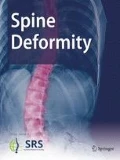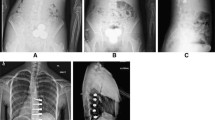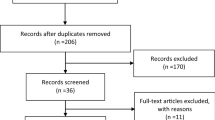Abstract
Background
Posterior spinal fusion (PSF) has proven to be a safe, reliable technique to treat spinal deformities in adolescents. In recent early reports, vertebral body tethering (VBT) is showing promise as a method to modulate growth, driving scoliosis correction, while offering the potential added benefit of maintaining some flexibility in the instrumented segment. With recent FDA humanitarian device exemption (HDE) approval, VBT is poised to become more widely available as a treatment for a subset of current PSF candidates. Our aim was to use approved criteria from a recent FDA IDE to determine who could have been tethered in the years preceding approval.
Methods
A retrospective analysis was performed of patients with idiopathic scoliosis treated with PSF or VBT at a large pediatric spine center from 1/1/2016 to 6/25/2019. Tethering indications followed the criteria outlined by an ongoing FDA IDE: age 8–16, Sanders bone age ≤ 4, primary thoracic curve between 35° and 60°, and lumbar curve < 35°. Risser sign and triradiate cartilage status were also employed to ascertain skeletal maturity in the absence of Sanders score.
Results
Of the 359 patients (78.6% female) who underwent PSF or VBT for idiopathic scoliosis, 75 (20.9%) met IDE criteria for VBT (57 had PSF and 18 had VBT). 284 were not appropriate for thoracic VBT: 77 (21.4%) had a non-thoracic primary curve, 80 (22.3%) were too mature at presentation, 36 (10.0%) had a lumbar curve > 34°, 9 (2.5%) had a main thoracic curve out of range, and 1 had a proximal thoracic curve > 40°. 81 patients (22.6%) had multiple exclusionary criteria.
Conclusions
After decades with a successful treatment for AIS (PSF), we are at an inflection point: VBT is conditionally approved by the FDA as an HDE device, unleashing more widespread use. Many pediatric spine surgeons will want to know what proportion of PSFs will someday be VBTs. If FDA IDE criteria are used to ensure that a VBT candidate has an appropriate maturity stage and scoliosis deformity pattern, 20.9% of our 359 surgical range patients would have qualified for thoracic VBT.
Level of evidence
Level III.




Similar content being viewed by others
References
U.S. Food and Drug Administration. The Tether TM - Vertebral Body Tethering System - H190005. 2019; https://www.fda.gov/medical-devices/recently-approved-devices/tethertm-vertebral-body-tethering-system-h190005. Accessed 20 February 2020
US Food and Drug Administration. Summary of Safety and Probable Benefit (SSPB). 2019; https://www.accessdata.fda.gov/cdrh_docs/pdf19/H190005b.pdf. Accessed 5 March 2020
Vaishya R, Shah M, Agarwal AK, Vijay V (2018) Growth modulation by hemi epiphysiodesis using eight-plate in Genu valgum in Paediatric population. J ClinOrthop Trauma 9(4):327–333
Gottliebsen M, Shiguetomi-Medina JM, Rahbek O, Moller-Madsen B (2016) Guided growth: mechanism and reversibility of modulation. J Child Orthop 10(6):471–477
Jupiter J, Burke D (2013) Scott’s parabola and the rise of the medical-industrial complex. Hand (NY) 8(3):249–252
Newton PO, Kluck DG, Saito W, Yaszay B, Bartley CE, Bastrom TP (2018) Anterior spinal growth tethering for skeletally immature patients with scoliosis: a retrospective look two to four years postoperatively. J Bone JtSurg Am 100(19):1691–1697
Samdani AF, Ames RJ, Kimball JS et al (2015) Anterior vertebral body tethering for immature adolescent idiopathic scoliosis: one-year results on the first 32 patients. Eur Spine J 24(7):1533–1539
Crawford CH 3rd, Lenke LG (2010) Growth modulation by means of anterior tethering resulting in progressive correction of juvenile idiopathic scoliosis: a case report. J Bone JtSurg Am 92(1):202–209
Newton PO (2020) Spinal growth tethering: indications and limits. Ann Transl Med 8(2):27
Newton PO, Bartley CE, Bastrom TP, Kluck DG, Saito W, Yaszay B (2020) Anterior spinal growth modulation in skeletally immature patients with idiopathic scoliosis—a comparison with posterior spinal fusion at 2 to 5 years postoperatively. J Bone JtSurg 102:769
Scott J (2001) Scott’s parabola: the rise and fall of a surgical technique. British Med J 323:1477
ClinicalTrials.gov. Vertebral Body Tethering Outcomes for Pediatric Idiopathic Scoliosis. 2020; https://clinicaltrials.gov/ct2/show/NCT03194568?term=vertebral+tether&draw=2&rank=1. Accessed 2 April 2020
Harris PA, Taylor R, Minor BL et al (2019) The REDCap consortium: Building an international community of software platform partners. J Biomed Inform 95:103208
Harris PA, Taylor R, Thielke R, Payne J, Gonzalez N, Conde JG (2009) Research electronic data capture (REDCap)–a metadata-driven methodology and workflow process for providing translational research informatics support. J Biomed Inform 42(2):377–381
Newton PO, Fricka KB, Lee SS, Farnsworth CL, Cox TG, Mahar AT (2002) Asymmetrical flexible tethering of spine growth in an immature bovine model. Spine (Phila Pa 1976) 27(7):689–693
Newton PO, Faro FD, Farnsworth CL et al (2005) Multilevel spinal growth modulation with an anterolateral flexible tether in an immature bovine model. Spine (Phila Pa 1976) 30(23):2608–2613
Karol LA (2019) The natural history of early-onset scoliosis. J PediatrOrthop. 39(Issue 6, Supplement 1 Suppl 1):S38–S43
Karol LA, Virostek D, Felton K, Jo C, Butler L (2016) The effect of the risser stage on bracing outcome in adolescent idiopathic scoliosis. J Bone JtSurg Am 98(15):1253–1259
Alanay A, Yucekul A, Abul K et al (2020) Thoracoscopic vertebral body tethering for adolescent idiopathic scoliosis: follow-up curve behavior according to sanders skeletal maturity staging. Spine (Phila Pa 1976) 45(22):E1483–E1492
Lavelle WF, Samdani AF, Cahill PJ, Betz RR (2011) Clinical outcomes of nitinol staples for preventing curve progression in idiopathic scoliosis. J PediatrOrthop 31(1 Suppl):S107-113
Betz RR, Ranade A, Samdani AF et al (2010) Vertebral body stapling: a fusionless treatment option for a growing child with moderate idiopathic scoliosis. Spine (Phila Pa 1976) 35(2):169–176
Cuddihy L, Danielsson AJ, Cahill PJ et al (2015) Vertebral body stapling versus bracing for patients with high-risk moderate idiopathic scoliosis. Biomed Res Int 2015:438452
ClinicalTrials.gov. Anterior Vertebral Body Tethering (AVBT) Using Zimmer Biomet Tether System or Dynesys System Components to Treat Pediatric Scoliosis. 2019; https://clinicaltrials.gov/ct2/show/NCT03506334. Accessed 5 March 2020
ClinicalTrials.gov. Safety Outcomes of Vertebral Body Tethering Technique. 2019; https://www.clinicaltrials.gov/ct2/show/NCT04119284?term=tethering&draw=2&rank=2. Accessed 5 March 2020
ClinicalTrials.gov. Safety and Efficacy Study of Spinal Tethering. 2020; https://www.clinicaltrials.gov/ct2/show/NCT02897453?term=NCT02897453&draw=2&rank=1. Accessed 5 March 2020
ClinicalTrials.gov. Vertebral Body Tethering Treatment for Idiopathic Scoliosis. 2019; https://www.clinicaltrials.gov/ct2/show/NCT03802656?term=tethering&draw=2&rank=1. Accessed 5 March 2020
Sanders JO, Khoury JG, Kishan S et al (2008) Predicting scoliosis progression from skeletal maturity: a simplified classification during adolescence. J Bone JtSurg Am 90(3):540–553
Sanders JO, Browne RH, McConnell SJ, Margraf SA, Cooney TE, Finegold DN (2007) Maturity assessment and curve progression in girls with idiopathic scoliosis. J Bone JtSurg Am 89(1):64–73
Hoernschemeyer DG, Boeyer ME, Robertson ME et al (2020) Anterior vertebral body tethering for adolescent scoliosis with growth remaining: a retrospective review of 2 to 5-year postoperative results. J Bone JtSurg Am 102(13):1169–1176
Miyanji F, Pawelek J, Nasto LA, Simmonds A, Parent S (2020) Safety and efficacy of anterior vertebral body tethering in the treatment of idiopathic scoliosis. Bone Jt J 102-B(12):1703–1708
Saal JA, Saal JS (2000) Intradiscalelectrothermal treatment for chronic discogenic low back pain: a prospective outcome study with minimum 1-year follow-up. Spine (Phila Pa 1976) 25(20):2622–2627
Minns RJ, Walsh WK (1997) Preliminary design and experimental studies of a novel soft implant for correcting sagittal plane instability in the lumbar spine. Spine (Phila Pa 1976) 22(16):1819–1825 (Discussion 1826-1817)
McCarthy KP, Chafetz RS, Mulcahey MJ, Frisch RF, D’Andrea LP, Betz RR (2010) Clinical efficacy of the vertebral wedge osteotomy for the fusionless treatment of paralytic scoliosis. Spine (Phila Pa 1976) 35(4):403–410
Dunn HK (1986) Anterior spine stabilization and decompression for thoracolumbar injuries. OrthopClin North Am 17(1):113–119
Anderson PA, Rouleau JP (2004) Intervertebral disc arthroplasty. Spine (Phila Pa 1976) 29(23):2779–2786
Zigler JE, Burd TA, Vialle EN, Sachs BL, Rashbaum RF, Ohnmeiss DD (2003) Lumbar spine arthroplasty: early results using the ProDisc II: a prospective randomized trial of arthroplasty versus fusion. J Spinal Disord Tech 16(4):352–361
Kostuik JP (2004) Complications and surgical revision for failed disc arthroplasty. Spine J 4(6 Suppl):289S-291S
Lu Y, McAnany SJ, Hecht AC, Cho SK, Qureshi SA (2014) Utilization trends of cervical artificial disc replacement after FDA approval compared with anterior cervical fusion: adoption of new technology. Spine (Phila Pa 1976) 39(3):249–255
Funding
None.
Author information
Authors and Affiliations
Contributions
Conception or design of work: PJC, JMF; Acquisition, analysis, or interpretation of data for the work: ARK, LCM, PJC, JMF; Drafting of work or revising it critically for important intellectual content: ARK, LCM, PJC, JMF; Final approval of version to be published: ARK, LCM, PJC, JMF.
Corresponding author
Ethics declarations
IRB approval
This study was approved by the Institutional Review Board.
Additional information
Publisher's Note
Springer Nature remains neutral with regard to jurisdictional claims in published maps and institutional affiliations.
Rights and permissions
About this article
Cite this article
Krakow, A.R., Magee, L.C., Cahill, P.J. et al. Could have tethered: predicting the proportion of scoliosis patients most appropriate for thoracic anterior spinal tethering. Spine Deform 9, 1005–1012 (2021). https://doi.org/10.1007/s43390-021-00296-5
Received:
Accepted:
Published:
Issue Date:
DOI: https://doi.org/10.1007/s43390-021-00296-5




